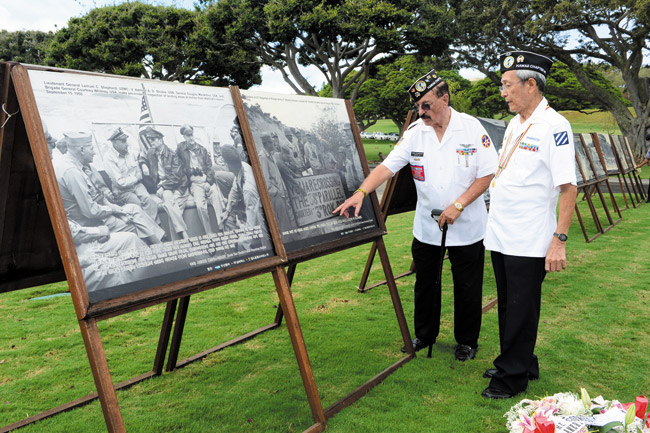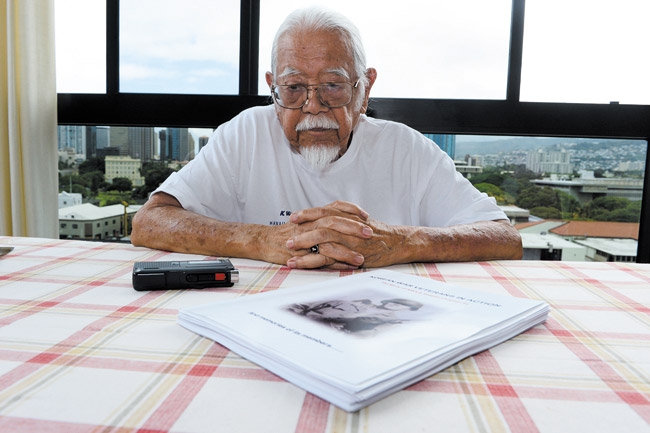The Forgotten War Remembered
Hawaii lost more men per capita than any state in the Korean War. A new book captures their memories, but they need donations to publish more
Veterans of the “Forgotten War” just want to be remembered. Thanks to the Korean War Veterans Association-Hawaii Chapter 1 (KWVA), soldiers and their stories are immortalized in a new book titled Korean War Vets in Action.
mw-nm-071013-koreanveterans-1
It’s the story of the men of KWVA Chapter 1.
As Gen. George S. Patton once declared, “Wars may be fought with weapons, but they are won by men.”
Thus, the personal accounts of life on the battlefield are insightful reflections of the courage, determination and patriotism of such men. Providing a perspective not often reported in the news, their stories are anecdotal truth from the trenches.
Lest such memories be buried with the passing of a generation, KWVA members began a book project a year ago to profile and document stories of Hawaii’s Korean War veterans, many now in their 80s.
A call-out to 90 surviving members yielded more than 50 vignettes that fill the 230-page book being released this month. The publication also commemorates the 60th anniversary of the end of the Korean War.
The Korea conflict, 1950 to 1953, is called the “Forgotten War” because it does not get the media and public attention of global World War II and the Vietnam War. Yet it is significant in the ideological realms of democracy and communism as the South Korea-U.S. and North Korea-China alliances tangle politically and economically even today – and the Korean War is not technically over, an armistice being signed not an endof-war-treaty.
For Hawaii, there is another distinction. Of the nearly 34,000 U.S. servicemen killed in the Korean War, 456 were from Hawaii – more per capita than any other state or territory.
But their sacrifices are not forgotten.
KWVA’s book acquaints readers with some of these unassuming yet courageous souls. For many years, their stories have been banter over breakfast at Likelike Drive Inn, where every Tuesday morning members get together to shoot the breeze.
Now that dialogue lives in the pages of Korean War Vets in Action.
Seeking donations to reach an $8,000 goal, members are optimistic that funds will come through once the public is aware of the organization and its project.
When you bare your soul, it can touch a heart, they profess.
Distribution of the first run of 400 books will go to local libraries, community colleges and universities, as well as high school JROTC units.
Public purchase of the books at $30 each benefit the educational project. Local companies, such as Aloha Shoyu and Likelike Drive Inn, are among the charter contributors.
KWVA, a nonprofit organization, is a branch of the national organization chartered by Congress in June 2008. The oldest and largest organization for Korean veterans, it currently is comprised of more than 14,500 members who served in Korea from 1945 to present.
Since 1996, Hawaii Chapter 1 has been the flagship of six chapters statewide. It is recognized by the Korean community as the key Korean veterans’ organization in the state.
At an anniversary ceremony sponsored by the Korean Consulate June 25 at National Memorial Cemetery of the Pacific at Punchbowl, military and government officials honored the veterans, calling them “true heroes.”
As assembled veterans gazed over gravesites, including 836 marked “unknown,” they reflected on the role they played in protecting national security and defending the principles of democracy.
Many were drafted out of high school and ordered to battle as their initiation to independent adulthood.
Kenneth Tashiro, 84, editor of the KWVA book, volunteered for Army duty in 1947 to take advantage of the GI Bill for college. He was born in Los Angeles and spent his childhood in various Mainland locations, including Gila River internment camp for relocated Japanese Americans during World War II. After military service and a career as a special education teacher, he and wife Taye retired in Kona. They moved to Honolulu three years ago.
The decorated soldier, including Republic of Korea Presidential Unit Citation and U.S. Bronze Star Medal, recalls harrowing experiences under attack in July 1950 as the 19th Infantry Regiment defended the Kum River in central Korea.
Tashiro writes in the book, “We moved into position two miles behind the front line. Our Hdq. Co. and IPW team came under attack. My Lt. took off with my jeep, stranding us 3 enlisted men … We walked southward and got strafed by a U.S. Air Force plane, shot at several times by North Korean soldiers and U.S. troops who thought we were the enemy because we were small and had Oriental faces.”
Tashiro’s descriptions of other narrow escapes and maneuvers under fire are presented vividly.
He also reflects, “War is hell. It was very rough for us who had been on soft occupation duty to be suddenly thrust into combat. We were outnumbered by the enemy, under-equipped, and morale was low as the U.S. Army kept suffering defeat after defeat.
“We lost many of our armed forces and suffered many casualties as did our United Nations allies. The South Korean civilian population also suffered, they lost homes and property, as well as lives of loved ones,” he writes.
Tashiro and his wife returned to Korea in 2008 on a revisit program sponsored by the Republic of Korea government.
He exclaims, “What a change! I’m glad that I did my part in bringing democracy to Korea.”
This spirit is reflected in other contributions to the book, including that of Farrington grad Stanley Fujii, 82, who served the in the Army’s 3rd Division, 7th Regiment, 2nd Battalion combat infantry in Korea.
“I completed basic training at Schofield Barracks and joined a group of soldiers bound for Korea,” he records in the book. “I didn’t realize the vast destruction of a war-torn country until I saw it with my own eyes.
“After landing in Inchon harbor, I was trucked to my unit in the mountains of Uijonbu north of Seoul near the 38th parallel … I spent all of 1952 fighting North Koreans. My unit was assigned to the mountains during that time. We slept in two-hour shifts in a sandbagged bunker, often finding huge rats that had made their way into the bunker to escape the weather.
“Like others who have served in wartime, living in a war zone changed my outlook on life,” Fujii states. “I counted down the days before my tour of duty would end and prayed that I would be among those returning home safely. Seeing the sun rise on my last day of duty lifted my spirits and instantly changed my mood from gloom to exhilaration. I had survived the war.”
Unlike the celebrated heroes of World War I and II, there was no victory or homecoming parade for the Korean War veterans. It wasn’t until years later at the 50th anniversary of the armistice that nationwide tributes remembered the brave men and women who served. As KWVA’s book rolls off the press, another generation of students and historians awaits the knowledge, ideals and wisdom these soldiers impart with their stories.
History is written on the pages of posterity.
For donations and book orders, contact KWVA Hawaii Chapter 1/Book Fund, c/o Richard Higa, treasurer; 1041 Kamahele St., Kailua HI 96734; phone 261-1122.







